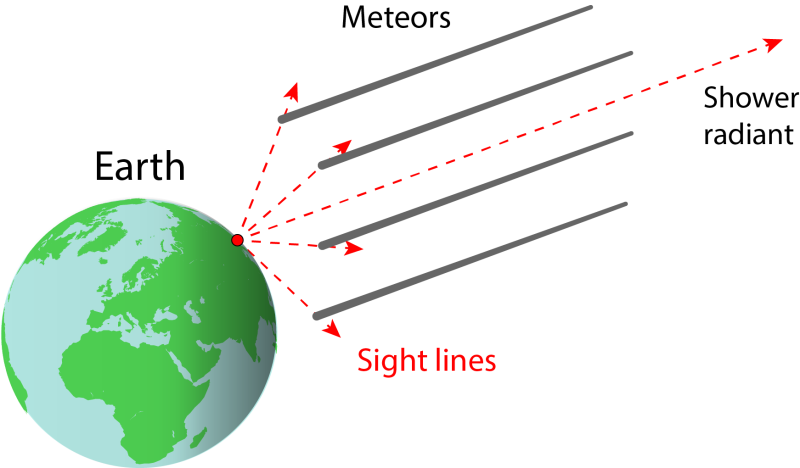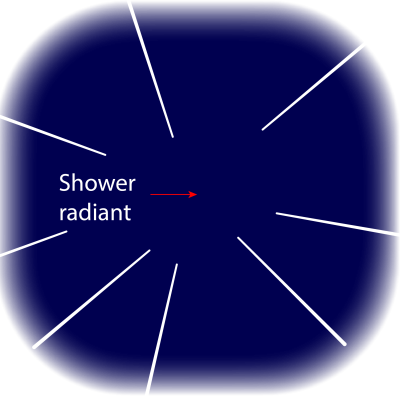Meteor Shower
Perseid meteor seen in 2016 from Poland. © Jacek Halicki 2016.
Meteor showers arise when the Earth passes through streams of debris left behind in the wake of comets and asteroids. Over time, the pieces of grit-like debris in these streams distribute themselves along the length of the parent object's orbit around the solar system.
Shooting stars are seen whenever one of these pieces of debris collides with the Earth's atmosphere, typically burning up at an altitude of around 70 to 100 km.
On certain days of the year the Earth's orbit passes through particularly dense streams, associated with comets or asteroids which have vented particularly large amounts of solid material to space, and this gives rise to an annual meteor shower. Such showers recur on an annual basis, whenever the Earth passes the particular point in its orbit where it crosses the particular stream of material.


The meteors that are associated with any particular meteor shower can be distinguished from others because their paths appear to radiate outwards from a common point on the sky, which points back in the direction from which their orbital motion brought them.
This is because the grit particles in any particular stream are travelling in almost exactly the same direction when they cross the Earth's orbit, owing to having very similar orbits to the parent object they came from. They strike the Earth from almost exactly the same direction, and at the same speed.
To see the most meteors, the best place to look is not directly at the radiant itself, but at any dark patch of sky which is around 30–40° away from it. It is at around this distance from the radiant that the most meteors will be seen.
By determining the position of this radiant point on the sky, it is possible to work out the orbit of the stream giving rise to any particular meteor shower. It is sometimes even be possible to identify the particular body responsible for creating the debris stream, if there is a known comet or asteroid with a very similar orbit.
Zenithal hourly rate
The rate at which any particular meteor shower produces meteors is quantified by its zenithal hourly rate (ZHR), which is expressed as the number of meteors seen per hour.
In practice, the number of meteors actually seen will by significantly less than the ZHR, which is the theoretical number of meteors which would be seen under perfect conditions. The observed number will depend on many factors, including sky conditions, the degree of light pollution in the observer's neighbourhood, and the altitude of the meteor shower's radiant in the night sky.
Even when looking at the same meteor shower, these factors will vary from one observer to another. For example, the altitude of the meteor shower's radiant will depend on the observer's geographic latitude. More information can be found here.
Provisional list of meteor showers
The table below lists meteor showers in 2026. The position of the radiant of each shower, and their predicted hourly rates, were taken from International Meteor Organisation's List of Meteor Showers.
Meteor showers in 2026
| Date | Meteor Shower |
Provisional ZHR |
| Date | Meteor Shower |
Provisional ZHR |
|
| 03 Jan 2026 22:36 UTC | Quadrantid | 120 | More information » |
| 19 Jan 2026 10:49 UTC | γ-Ursae Minorid | 3 | More information » |
| 08 Feb 2026 08:13 UTC | α-Centaurid | 6 | More information » |
| 14 Mar 2026 23:00 UTC | γ-Normid | 6 | More information » |
| 22 Apr 2026 19:17 UTC | Lyrid | 18 | More information » |
| 06 May 2026 09:22 UTC | η-Aquariid | 40 | More information » |
| 08 May 2026 23:23 UTC | η-Lyrid | 3 | More information » |
| 10 Jun 2026 20:31 UTC | Daytime Arietid | 50 | More information » |
| 29 Jul 2026 03:51 UTC | Piscis Austrinid | 5 | More information » |
| 30 Jul 2026 12:29 UTC | Southern δ-Aquariid | 25 | More information » |
| 30 Jul 2026 12:44 UTC | α-Capricornid | 5 | More information » |
| 13 Aug 2026 02:10 UTC | Perseid | 150 | More information » |
| 18 Aug 2026 07:01 UTC | κ-Cygnid | 3 | More information » |
| 01 Sep 2026 09:29 UTC | Aurigid | 6 | More information » |
| 09 Sep 2026 17:59 UTC | September ε-Perseid | 5 | More information » |
| 27 Sep 2026 18:41 UTC | Daytime Sextantid | 5 | More information » |
| 10 Oct 2026 16:13 UTC | Southern Taurid | 5 | More information » |
| 11 Oct 2026 16:30 UTC | δ-Aurigid | 2 | More information » |
| 18 Oct 2026 18:00 UTC | ε-Geminid | 3 | More information » |
| 21 Oct 2026 18:29 UTC | Orionid | 15 | More information » |
| 24 Oct 2026 18:50 UTC | Leonis Minorid | 2 | More information » |
| 12 Nov 2026 18:18 UTC | Northern Taurid | 5 | More information » |
| 18 Nov 2026 00:35 UTC | Leonid | 15 | More information » |
| 28 Nov 2026 14:49 UTC | November Orionid | 3 | More information » |
| 07 Dec 2026 11:50 UTC | Puppid-Velid | 10 | More information » |
| 09 Dec 2026 11:05 UTC | Monocerotid | 2 | More information » |
| 12 Dec 2026 09:55 UTC | σ-Hydrid | 3 | More information » |
| 14 Dec 2026 13:50 UTC | Geminid | 120 | More information » |
| 16 Dec 2026 08:18 UTC | Comae Berenicid | 3 | More information » |
| 20 Dec 2026 06:38 UTC | December Leonis Minorid | 5 | More information » |
| 22 Dec 2026 22:18 UTC | Ursid | 10 | More information » |